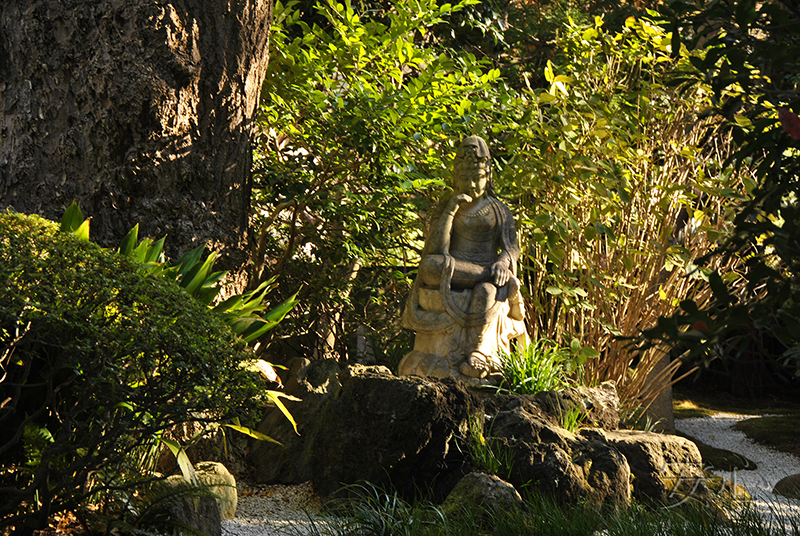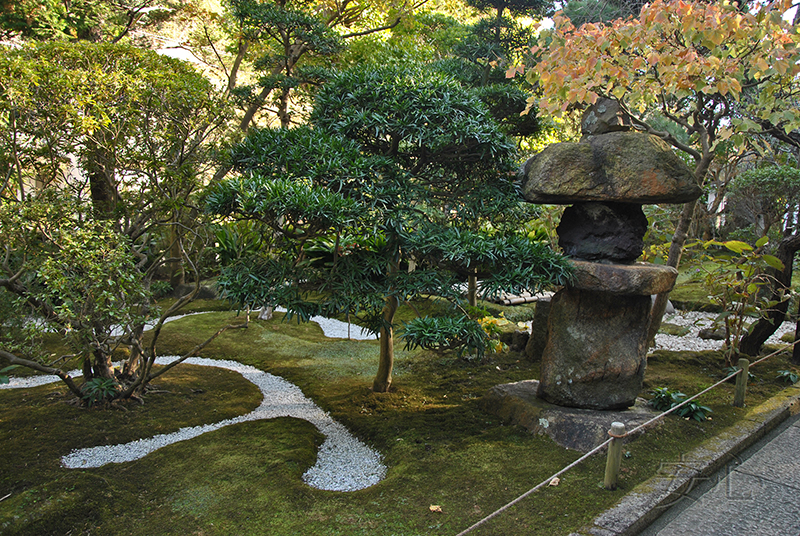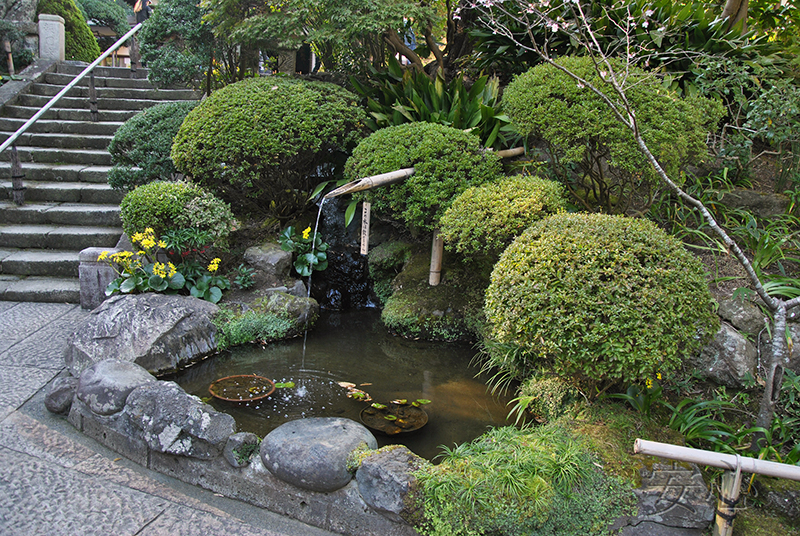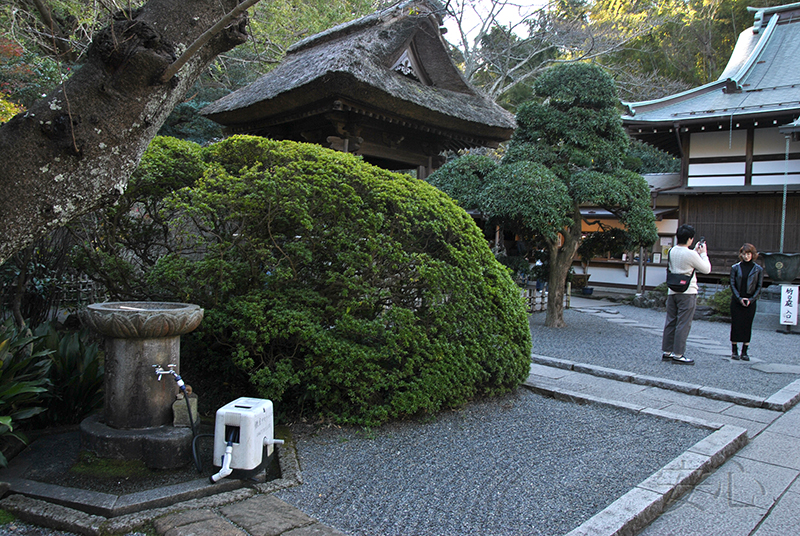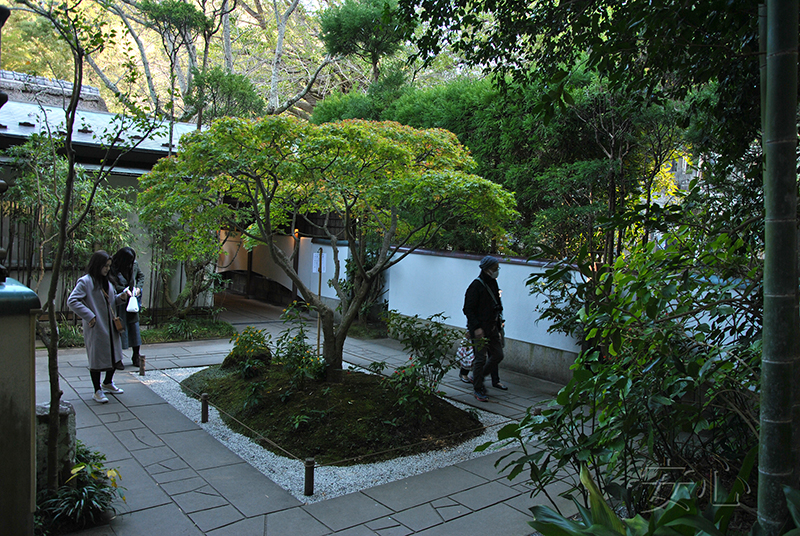
Hokoku-ji temple garden, Kamakura
Hokoku-ji Temple was a family temple of both the Ashikaga and Uesugi clans. However, they vied with each other. Its founder, Tengan Eko (posthumous Buddhist name - Butsujo-Zenji) was a high-level priest. He studied under the founder of the Engakuji Temple, Mugaku Sogen, who was invited from China. Tengan Eko also traveled to China himself to continue his studies.
The temple is also known as Take-dera, what means "Bamboo Temple" as there is a wonderful bamboo grove and gardens. And we came here because of these gardens.
The entrance is through the wooden Sanmon Gate.
Then you need to follow the road. On the right is a hill covered with plants, and on the left is a very interesting garden. A dry stream of light-colored pebbles winds through the hills covered with a soft carpet of moss.
In one place, a path of rough stepping stones leads us to the statue of the goddess of mercy. That day it was especially beautifully illuminated by the rays of the November sun.
Of course, "it leads" is just a figurative expression, the entire territory of the dry garden is fenced, and you can't even walk along a stone path. But this is not particularly necessary, the garden will stretch along the road, and everything is perfectly visible.
A little further away, a huge stone lantern caught our attention. I like these rough lanterns made of stones very much.
Behind the lantern is a well. Stepping stones also lead to it.
The right side ends with a small pond. The water flows from the bamboo chute that goes through one of the azalea bushes. It gives the pond the resemblance to a huge tsukubai.
Climbing the stairs, we found ourselves in front of the main building, which was rebuilt after the Great Kanto Earthquake. It enshrines the Shaka-nyorai-zazo (seated Shakyamuni), sculpted by famous Buddhist sculptor, Takuma Hogen. A statue of Bustujo Zenji, sculpted in 1347 is also enshrined at the annex (kasho-do). To the right of the main hall is the bell tower retains the original thatched roof.
There is another building on the left. At the entrance is a stunning pine bonsai, located in a bowl next to a stone. A small maple tree grows nearby. The fact that it was already practically leafless only added to the attractiveness of the tree, showing in all its glory the graphics of drooping branches and an elegant trunk.
All these territories you can see for free, and only if you want to go further, to the bamboo grove and gardens, you need to pay for the entrance.
The first garden is quite small, like a tsubo. It consists of one low hill, surrounded by light pebbles. The main accent is the formed maple growing in the center.
A bamboo grove begins behind the first garden. We were lucky that day with the weather, the sun made its way through the dense thickets, drawing intricate patterns on the ground strewn with old foliage and illuminating the way for tourists passing along the path. But on dark days here, I think, it can be gloomy.
If you look up, you can see that all the trunks are tied together with a rope. I do not know what for, I can only guess that in this way they protect the trunks from falling and breaking off during strong winds or snowfalls. But these are just my guesses. After all, I have never seen this anywhere else. Judging by the photos of other people, the ropes are not always present. So the probability that this is due to the winter period and snowfalls is very high.
We even met gardeners doing the strapping. The oldest of them, apparently, was in charge. He not only explained to the young people what to do and how, but he climbed up himself, while the others held the stairs.
The most beautiful part of this grove is where the tea pavilion stands. Perhaps the lighting here again played a major role, but to me it seemed just magical!
Unfortunately, we had plans to visit several gardens at that day, and there was no time to sit in such a charming atmosphere, drink delicious tea, looking at the bamboo grove. But next time we will definitely do it!
If from tsubo to go not directly into the bamboo grove, but turn to the right, then you will come to the back of the main hall. There is a dry garden with a small pond.
The pond takes water from a narrow stream flowing down the hill. And, just like in the first pond, a thin stream of water flows from the bamboo chute.
Behind this garden, up the hill, there are the caves said to be the burial grounds of ashes of the Ashikaga family, including those of Ietoki and Yoshihisa, father and son, both of whom died of seppuku. There is a lot of information about this story in the Internet, so I will not repeat it here.
From here you can see a part of the pond from the lower garden.
In my opinion, the uniqueness of this place lies in its location. The combination of tea and bamboo forest I have met only here and at the Okochi Sanso villa in Kyoto. And this really gives to the tea action a special charm. Sitting in such a beautiful pavilion, looking at the bamboo grove, catching the rays of the sun penetrating through the long trunks, feeling the unity with a wonderful garden - all this worth to come here more than once!
Garden Information:
Address: 2 Chome-7-4 Jomyoji, Kamakura, Kanagawa 248-0003, Japan
Opening hours: from 9 a.m. to 4 p.m.
anshin©2011All rights reserved. When using the materials of the site, reference is obligatory.
Proposals for co-operation, as well as comments and suggestions on the site please send to the address: anshinsad@gmail.comtel: +7 (965) 121-80-60, 10am-20pm



